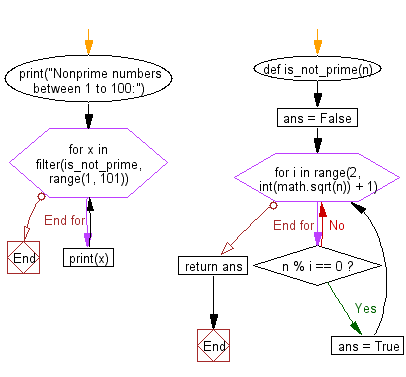Python: Identify nonprime numbers between 1 to 100
Find Non-Prime Numbers
Write a Python program to identify non-prime numbers between 1 and 100 (integers). Print the non-prime numbers.
Sample Solution:
Python Code:
# Import the 'math' module to use mathematical functions.
import math
# Define a function 'is_not_prime' to check if a number is not prime.
def is_not_prime(n):
# Initialize the answer as False.
ans = False
# Iterate through potential divisors from 2 to the square root of 'n' (inclusive).
for i in range(2, int(math.sqrt(n)) + 1):
# If 'n' is divisible by 'i', set the answer to True.
if n % i == 0:
ans = True
# Return the final answer.
return ans
# Print a message indicating the purpose of the following loop.
print("Nonprime numbers between 1 to 100:")
# Use the 'filter' function to create an iterable of nonprime numbers.
# Iterate through the filtered numbers and print each one.
for x in filter(is_not_prime, range(1, 101)):
print(x)
Sample Output:
Nonprime numbers between 1 to 100: 4 6 8 9 10 12 14 15 .. 90 91 92 93 94 95 96 98 99 100
Explanation:
Here is a breakdown of the above Python code:
- Module Import:
- The code imports the "math" module to use mathematical functions, specifically, the square root function.
- Function definition - is_not_prime:
- A function named "is_not_prime()" is defined to check if a given number is not prime.
- The function uses a loop to iterate through potential divisors and sets the answer to True if any divisor is found.
- Printing message:
- A message is printed to indicate the purpose of the following loop.
- Filtering and printing nonprime numbers:
- The "filter()" function is used to create an iterable of nonprime numbers in the range from 1 to 100.
- The iterable is then looped through, and each nonprime number is printed.
Flowchart:

For more Practice: Solve these Related Problems:
- Write a Python program to list all composite numbers between 1 and 100 by checking for non-prime conditions.
- Write a Python program to generate non-prime numbers within a specified range by testing for factors.
- Write a Python program to filter out prime numbers from a range and output the remaining composite numbers.
- Write a Python program to compute and print all non-prime integers between 1 and 100 using a helper function.
Go to:
Previous: Write a Python program to generate and prints a list of numbers from 1 to 10.
Next: Write a Python program to make a request to a web page, and test the status code, also display the html code of the specified web page.
Python Code Editor:
Have another way to solve this solution? Contribute your code (and comments) through Disqus.
What is the difficulty level of this exercise?
Test your Programming skills with w3resource's quiz.
